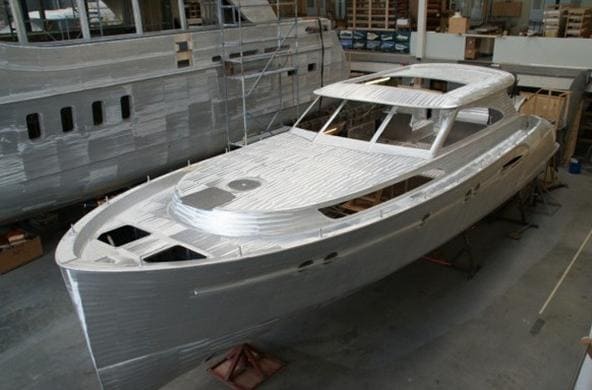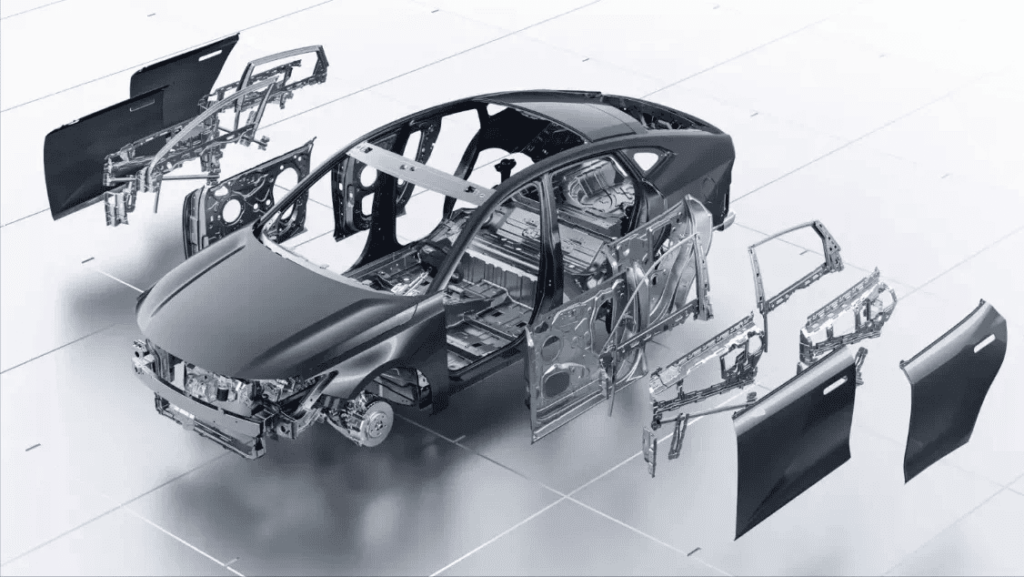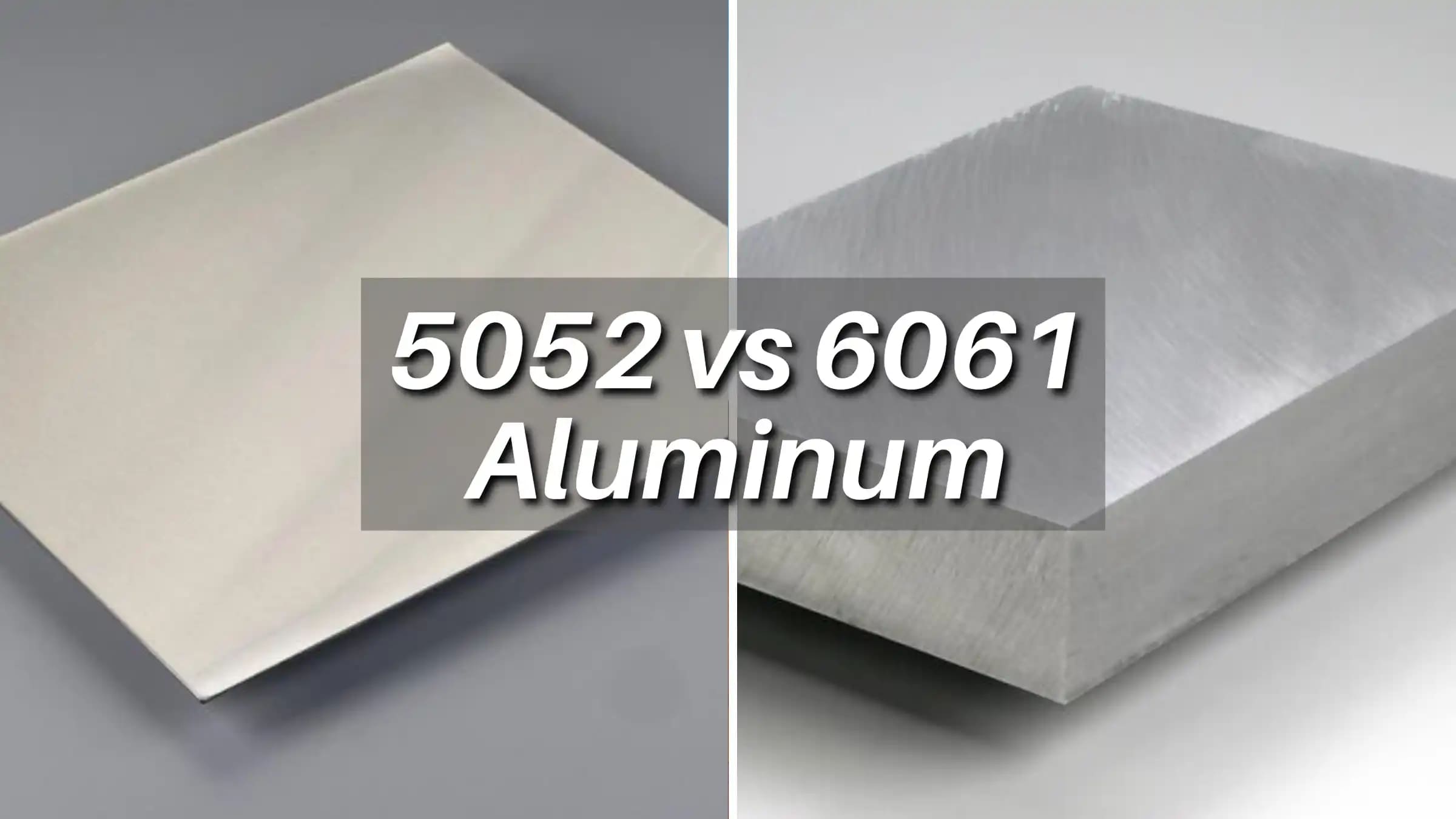5052 Aluminum vs. 6061 Aluminum
Aluminum alloy is favored in many fields due to its excellent properties such as light weight, corrosion resistance, and high strength. 5052 aluminum and 6061 aluminum, commonly used aluminum alloys, have significant differences in their chemical composition, physical and mechanical properties, and applications. Understanding these differences is critical to making informed decisions on specific projects.
1.Comparison of chemical and physical properties
(I) Chemical composition
Elements in 5052 aluminum: The main alloying elements are magnesium (Mg, content 2.2 – 2.8%) and chromium (Cr, content 0.15 – 0.35%), in addition to trace elements such as silicon (Si), iron (Fe), copper (Cu), manganese (Mn), and zinc (Zn).
Elements in 6061 aluminum: The main alloying elements are magnesium (Mg, content 0.8 – 1.2%) and silicon (Si, content 0.4 – 0.8%), and also contain elements such as chromium (Cr), iron (Fe), copper (Cu), manganese (Mn), zinc (Zn) and titanium (Ti).
(II) Effect on mechanical properties
5052 aluminum: The higher magnesium content enhances the overall strength and corrosion resistance, and is suitable for environments with high requirements for these properties.
6061 aluminum: The combination of magnesium and silicon imparts good mechanical properties, such as high strength and good machinability, and other elements further optimize its performance in a wide range of structural applications.
(III) Physical properties
Density: 5052 aluminum has a density of 2.68 g/cm³, which is slightly lighter than 6061 aluminum and is suitable for weight-sensitive applications; 6061 aluminum has a density of about 2.70 g/cm³, and this difference may be more important in precision engineering.
Thermal conductivity: 5052 aluminum has a thermal conductivity of 138 W/mK, which is suitable for applications that require heat dissipation; 6061 aluminum has a thermal conductivity between 151 – 167 W/mK, which is very suitable for environments with high heat dissipation requirements, such as heat sinks.
Electrical conductivity: 5052 aluminum has a low electrical conductivity due to its high magnesium content and is not very suitable for electrical applications; 6061 aluminum has relatively good electrical conductivity and is more suitable for electrical components and applications.
Corrosion resistance: 5052 aluminum is known for its excellent corrosion resistance, especially in marine and saltwater environments; 6061 aluminum also has good corrosion resistance, but its effect in seawater is slightly inferior to 5052 aluminum.

2.Mechanical Properties Comparison
(I) Tensile Strength Comparison
5052 aluminum: The tensile strength is about 210-260 MPa, which is suitable for applications requiring medium strength.
6061 aluminum: The tensile strength is about 290-310 MPa, which can support applications requiring higher strength.
(II) Yield Strength Comparison
5052 aluminum: The yield strength is about 130 MPa, which has medium resistance to deformation under load.
6061 aluminum: The yield strength is about 240 MPa, which has better resistance to permanent deformation under impact.
(III) Hardness Test
5052 aluminum: The Brinell hardness is 61 HB, which is easier to process, but has poor wear resistance.
6061 aluminum: The Brinell hardness is about 95 HB, which has higher wear resistance and durability.
(IV) Fatigue strength
5052 aluminum: has medium fatigue strength and is suitable for applications with medium fatigue.
6061 aluminum: has higher fatigue strength and is more suitable for applications with higher cycles and vibrations.

3.Formability and Machinability
(I) Machinability
5052 aluminum: average machinability, difficult to machine, higher magnesium content leads to more tool damage, requires careful control of machining parameters, poor surface finish, and short tool life.
6061 aluminum: has good machinability, its balanced composition of magnesium and silicon gives it good machining performance, can achieve higher machining speeds and better surface finish, and is the first choice for precision parts and composite parts.
(II) Weldability
5052 aluminum: has good weldability, suitable for projects that require a lot of welding, can use technologies such as TIG and MIG welding, with less risk.
6061 aluminum: has good weldability, but requires more careful control during welding to avoid problems such as cracking. It is usually recommended to perform pre-weld and post-weld heat treatment to reduce the risk of welding defects and restore the mechanical properties of the heat-affected zone.
(III) Formability and Characteristics
5052 aluminum: has excellent formability and is suitable for complex shapes and designs. Its high ductility makes it less prone to cracking during forming operations, which is very beneficial for applications that require a large number of forming operations.
6061 aluminum: has moderate formability, is not as easy to form as 5052 aluminum, is more suitable for simpler shapes, and requires a larger bending radius and more careful operation when forming to avoid cracking.
(IV) Heat treatment and hardening
6061 heat treatability: 6061 aluminum can be heat treated to enhance its mechanical properties. The T6 state is the most common heat treatment method, which involves solution heat treatment and artificial aging, making it suitable for a wide range of applications that require different levels of strength and durability.
5052 non-heat treatability: 5052 aluminum cannot be heat treated, but its strength can be increased through work hardening, such as through processes such as rolling or cold working, making it suitable for applications that require moderate strength and high ductility.
4.Application Industry
(I) Application of 5052 aluminum
Marine industry: Due to its excellent corrosion resistance, especially in saltwater environments, it is an ideal choice for hulls, ship superstructures and other marine components.
Automotive parts: Commonly used in fuel tanks, panels and other components, good formability and corrosion resistance make it suitable for a variety of panels and structural components.
Consumer products: Widely used in consumer products such as electronics, kitchenware and household appliances, high strength, light weight and good corrosion resistance make it an ideal choice for these applications.
Aerospace: Often used in non-critical components such as pipes, brackets and non-load-bearing panels, which is conducive to corrosion resistance and weight reduction.

(II) Application of 6061 aluminum
Structural components: Due to its excellent strength and practicality, it is widely used in structural applications in construction projects such as bridges, buildings and pipelines, providing strong and durable support structures for these projects.
Aerospace and defense: Used to manufacture various structural parts and components such as aircraft frames, landing gear and military vehicles, high strength and heat treatable properties make it very suitable for these fields.
Automotive Industry: Suitable for automotive parts that require good mechanical properties and corrosion resistance, such as suspension components, engine components and structures. It can be processed into precision parts and is also ideal for customized automotive applications.
Recreational Equipment: Popular in the manufacture of leisure equipment such as bicycles, boats and sporting goods, the high strength and light weight provide the necessary durability and performance while maintaining the practicality and easy operation of the equipment.

5.Factors to consider when choosing
(I) Project requirements
Strength: 5052 aluminum has medium strength and is suitable for applications that require high formability and corrosion resistance but not extremely high strength; 6061 aluminum has higher strength and is ideal for structural applications and components that need to withstand huge loads or pressures.
Corrosion resistance: 5052 aluminum has excellent corrosion resistance and is particularly suitable for saltwater and marine environments and applications exposed to chemicals or corrosive conditions; 6061 aluminum has good corrosion resistance, but is not as good as 5052 aluminum in highly corrosive environments, but it is sufficient for most general applications.
Stability: 5052 aluminum has high formability and is suitable for making complex shapes and designs; 6061 aluminum has good formability, but is more suitable for simpler shapes and requires more careful operation during forming to avoid cracking.
(II) Budget constraints
5052 aluminum: Generally more affordable than 6061 aluminum, it is an economical choice for projects with tight budgets or that do not require the excellent performance of 6061 aluminum.
6061 aluminum: Due to its higher strength and wider range of uses, it is usually more expensive, but its enhanced mechanical properties and wider range of applications make its cost difference reasonable.
(III) Environmental conditions
5052 aluminum: Well suited for environments with high humidity, salt water immersion or other corrosive conditions, and its excellent corrosion resistance ensures long-lasting durability in these environments.
6061 aluminum: Suitable for a variety of environments, but may require protective coatings or treatments in highly corrosive conditions, performs well in most general environments, and is often used in structural applications.
(IV) Required mechanical properties
Tensile strength: 5052 aluminum has moderate tensile strength and is not suitable for high stress structural uses; 6061 aluminum has higher tensile strength and is suitable for applications that require higher load-bearing capacity.
Yield strength: 5052 aluminum has a lower yield strength, which may limit its use in applications where deformation resistance is critical; 6061 aluminum has a higher yield strength and is suitable for parts that must maintain shape and integrity under pressure.
Hardness: 5052 aluminum is less hard and easier to machine, but less suitable for wear applications; 6061 aluminum is harder and offers better wear resistance and durability for applications involving friction or impact.
Conclusion
5052 aluminum and 6061 aluminum have their own advantages in different applications. When selecting an aluminum alloy, the specific needs of the project should be carefully evaluated, including factors such as strength, corrosion resistance, formability, budget constraints and environmental conditions to ensure that the alloy that best meets the project needs is selected to achieve the best performance and service life of the final product.
